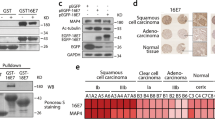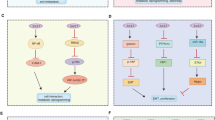Abstract
Human papillomavirus (HPV) E7 is essential in inducing S-phase progression in differentiating epithelial cells. We have previously shown that HPV-16 E7 activity can be controlled by a direct interaction with the viral transcriptional activator E2, thereby inhibiting transforming potential of E7. We have extended these analyses to show that E2 induces a generalized re-localization of E7 within the cell nucleus, one potential consequence of which is the inhibition of E7-induced degradation of pRb. Most importantly, we show that E2 can also inhibit the ability of E7 to induce centrosome abnormalities, thus preventing aberrant mitoses. Taken together, these studies highlight the central importance of E2 in controlling the functions of E7, independently of the ability of E2 to regulate transcription.
This is a preview of subscription content, access via your institution
Access options
Subscribe to this journal
Receive 50 print issues and online access
$259.00 per year
only $5.18 per issue
Buy this article
- Purchase on Springer Link
- Instant access to full article PDF
Prices may be subject to local taxes which are calculated during checkout




Similar content being viewed by others
References
Araujo FD, Stracker TH, Carson CT, Lee DV, Weitzman MD . (2005). Adenovirus type 5 E4orf3 protein targets the Mre11 complex to cytoplasmic aggresomes. J Virol 79: 11382–11391.
Boyer SN, Wazer DE, Band V . (1996). E7 protein of human papilloma virus-16 induces degradation of retinoblastoma protein through the ubiquitin–proteasome pathway. Cancer Res 56: 4620–4624.
Donaldson MM, Boner W, Morgan IM . (2007). TopBP1 regulates human papillomavirus type 16 E2 interaction with chromatin. J Virol 81: 4338–4342.
Doorbar J . (2006). Molecular biology of human papillomavirus infection and cervical cancer. Clin Sci (London) 110: 525–541.
Duensing S, Duensing A, Flores ER, Do A, Lambert PF, Münger K . (2001). Centrosome abnormalities and genomic instability by episomal expression of human papillomavirus type 16 in raft cultures of human keratinocytes. J Virol 75: 7712–7716.
Duensing S, Duensing A, Lee DC, Edwards KM, Piboonniyom SO, Manuel E et al. (2004). Cyclin-dependent kinase inhibitor indirubin-3′-oxime selectively inhibits human papillomavirus type 16 E7-induced numerical centrosome anomalies. Oncogene 23: 8206–8215.
Duensing S, Lee LY, Duensing A, Basile J, Piboonniyom S, Gonzalez S et al. (2000). The human papillomavirus type 16 E6 and E7 oncoproteins cooperate to induce mitotic defects and genomic instability by uncoupling centrosome duplication from the cell division cycle. Proc Natl Acad Sci USA 97: 10002–10007.
Duensing S, Münger K . (2003). Human papillomavirus type 16 E7 oncoprotein can induce abnormal centrosome duplication through a mechanism independent of inactivation of retinoblastoma protein family members. J Virol 77: 12331–12335.
Funk JO, Waga S, Harry JB, Espling E, Stillman B, Galloway DA . (1997). Inhibition of CDK activity and PCNA-dependent DNA replication by p21 is blocked by interaction with the HPV-16 E7 oncoprotein. Genes Dev 11: 2090–2100.
Gammoh N, Grm HS, Massimi P, Banks L . (2006). Regulation of human papillomavirus type 16 E7 activity through direct protein interaction with the E2 transcriptional activator. J Virol 80: 1787–1797.
Grm HS, Massimi P, Gammoh N, Banks L . (2005). Crosstalk between the human papillomavirus E2 transcriptional activator and the E6 oncoprotein. Oncogene 24: 5149–5164.
He W, Staples D, Smith C, Fisher C . (2003). Direct activation of cyclin-dependent kinase 2 by human papillomavirus E7. J Virol 77: 10566–10574.
Heck DV, Yee CL, Howley PM, Münger K . (1992). Efficiency of binding the retinoblastoma protein correlates with the transforming capacity of the E7 oncoproteins of the human papillomaviruses. Proc Natl Acad Sci USA 89: 4442–4446.
Kurg R, Sild K, Ilves A, Sepp M, Ustav M . (2005). Association of bovine papillomavirus E2 protein with nuclear structures in vivo. J Virol 79: 10528–10539.
Massimi P, Pim D, Bertoli C, Bouvard V, Banks L . (1999). Interaction between the HPV-16 E2 transcriptional activator and p53. Oncogene 18: 7748–7754.
Patel D, Incassati A, Wang N, McCance DJ . (2004). Human papillomavirus type 16 E6 and E7 cause polyploidy in human keratinocytes and up-regulation of G2-M-phase proteins. Cancer Res 64: 1299–1306.
Vogelstein B, Kinzler KW . (2004). Cancer genes and the pathways they control. Nat Med 10: 789–799.
Yoshinouchi M, Yamada T, Kizaki M, Fen J, Koseki T, Ikeda Y et al. (2003). in vitro and in vivo growth suppression of human papillomavirus 16-positive cervical cancer cells by E6 siRNA. Mol Ther 8: 762–768.
Acknowledgements
We thank Daniela Gardiol, David Pim and Miranda Thomas for comments on the paper. We also thank Karl Münger for providing anti-HPV-16 E7 monoclonal antibody. This work was supported in part by a research grant from the Associazione Italiana per la Ricerca sul Cancro. EI, DJ and JD were supported by the UK Medical Research Council.
Author information
Authors and Affiliations
Corresponding authors
Rights and permissions
About this article
Cite this article
Gammoh, N., Isaacson, E., Tomaić, V. et al. Inhibition of HPV-16 E7 oncogenic activity by HPV-16 E2. Oncogene 28, 2299–2304 (2009). https://doi.org/10.1038/onc.2009.78
Received:
Revised:
Accepted:
Published:
Issue Date:
DOI: https://doi.org/10.1038/onc.2009.78
Keywords
This article is cited by
-
HPV E2, E4, E5 drive alternative carcinogenic pathways in HPV positive cancers
Oncogene (2020)
-
The transcriptional regulator gene E2 of the Human Papillomavirus (HPV) 16 influences the radiosensitivity of cervical keratinocytes
Radiation Oncology (2012)
-
HPV16 E2 could act as down-regulator in cellular genes implicated in apoptosis, proliferation and cell differentiation
Virology Journal (2011)



